Want to get attention with an open-class sportbike? Just give it the most power. Crave some “Bike of the Year” trophies for your factory’s middleweight sportbike? No prob: just win some AMA races (okay, maybe that’s kind of hard to do, but at least it’s a clear formula). But what makes the best lightweight sportbike? That’s a harder problem to solve, which might explain why there have been so few lightweight sportbike models available in the USA. In fact, aside from the Honda CBR250R, there has been just one model of note since Reagan was president: Kawasaki’s Ninja 250.
The Ninjette hit the sweet spot: affordable, easy to ride and entertaining for everybody from rank beginners to experienced roadracers. In fact, the design was so good it didn’t just dominate its market niche—it was its market niche, and hence didn’t even get a serious makeover for 20 years (the Model T was only built for 18). In 2008, it went under the knife, getting huge revisions that added styling, handling, braking, suspension and user-friendliness—while adding weight and sapping a few valuable top-end horsepower. Still, the big update was enough, keeping the 250R as one of the best-selling motorcycles in the USA.
Yep, best selling. In the first two quarters of 2012, the entire U.S. motorcycle industry sold 2100 middleweight, 4300 heavyweight (yes, the big bikes outsell the 600s—blame tight credit for that one) and 5800 lightweight sportbikes, according to MIC data. OEMs seldom release model-by-model sales data, but we’re guessing Big Green is moving the most 250s.
But that apparently wasn’t enough for Kawasaki Heavy Industries, which, in 2009 (just a year after the 2008 250R was launched) decided to once again heavily revamp the littlest Ninja to create the “ultimate lightweight sportbike.” The old Ninja was good, but nowhere near “ultimate”—it’s pretty wheezy at freeway speeds and though it edges out the 23-ish horsepower Hondas, the 26-ish hp it puts to the rear tire isn’t enough to keep many new buyers interested or satisfied for more than a short while before they move “up” to a bigger-displacement machine. Of course, that’s not a bad thing, as they usually move up to a bigger Ninja, but Kawasaki is known for making powerful motorcycles that dominate their classes.
Job one was to add power, so the design team, led by Product Developer Kunihiro Tanaka, upped capacity to 296cc by adding 7.8mm of stroke. And why not? There is no World Superbike class for 250cc sportbikes, after all. So why not a 350 or 400? Size: a bigger bore would mean wider cases, Tanaka told me at his first-ever Mexican dinner, which would mean a wider, heavier frame…and Kawi’s already done a 500cc sportbike, if you recall. For markets that need a 250 for insurance or licensing reasons, a 250cc model—that still receives the 300’s styling and technical changes—will be available.
Tanaka’s crew didn’t stop with a stroker block. Forty-five percent of the engine’s parts are new—new cylinder head, new cases that flow more oil, bigger valves, trimmed-down hard-anodized pistons, shorter con-rods and even a revised engine balancer. Compression drops a point, to 10.6:1, allowing cooler operating temperatures and regular-unleaded gas. There’s more oil capacity (up to 2.4 liters from 1.7) and joy of joys for home mechanics—a spin-on oil filter, which enables an oil change without removing any bodywork. Oh, and did we mention the fuel injection? Dual 32mm throttle bods with dual throttle valves.
But wait, there’s more: the FCC clutch. FCC is a Japanese clutch manufacturer, and the unit in the Ninja is prized not just for the slipper function—which will help minimize wheel-locking and high-siding from sloppy downshifts—but also the lighter, noob-friendly clutch feel. That clutch is paired with a revised tranny that’s both smoother-acting and more durable. The rear sprocket is three teeth smaller to allow higher top speeds, thanks to that big ol’ 296.
And you have to match that new-found power with a revised chassis, no? Though the old bike was a good handler, that was more due to its light weight than the aging tube-steel frame design. The 2013 uses high-tensile tubing that’s 150 percent stronger, and there’s new gusseting and other changes to make the frame more rigid, rigid enough to rubber-mount the front of the engine. Wheels are also new, with an eye-catching 10-spoke design and a 1/2-inch wider rear—tires are specially developed IRC Road Winners, a 110/70-17 front and 140/70-17 rear, but still radial. Other numbers of interest: the wheelbase stretches .2 inches to 55.3, and the seat is a half-inch higher at 30.9 but is narrower at the front to keep it manageable for the short-of-inseam.
Braking comes from a single disc front and rear, still a 290mm petal-style disc with a two-piston caliper in front and a one-pot in back. But this year there’s optional ABS, a compact Nissan system that adds just four pounds to the weight of the bike. Like the brakes, the suspension is the same basic equipment—a 37mm non-adjustable fork and a preload-adjustable bottom-link Uni-Trak monoshock—with revised settings to better cope with both bumpy urban pavement and swoopy mountain roads. “New riders won’t get bored with it in six months,” development rider Derek Keyes—who has ridden the new bike all over the world—told us.
The technical changes are for the “researchers,” according to Product Manager Croft Long. These are new buyers who want a “real” sportbike and will pay extra for the privilege. They pore over the technical data and are looking for the most technology for the buck, something the 300 has in quantity.
There are also “uneducated” buyers, who may walk into a dealership and fall in love with a glittering new sportbike, regardless of what’s underneath that sleek plastic. For the second group, the styling has been seriously re-worked, from the dual headlamps to the “floating” windscreen design and minimalist tail section to the knurled aluminum footpegs (no stodgy-looking rubber pads here). The changes are intended to make the 300 more closely resemble its bigger brothers—mission accomplished. But the styling is practical, too—the fuel tank still holds 4.5 gallons (down from 4.8, to make room for the ABS unit), the digital instrument panel is easy to read and has more information, there’s a flip-up tool tray under the seat and a clever ducting system to keep heat away from the rider at low speeds.
Yeah, yeah, yeah. I’ve sat through many a tech briefing where the product managers and development people told me how shaving 12 grams here and 1.3mm there would change the sportbike world As We Know It. I’ve ridden every Ninja 250 iteration, raced several of them, and attended the 250R press launch for a lesser publication. My main concern was how to spin this into a decent story. At the end of the day, it’s a 296cc parallel Twin, a few pounds heavier than last year, with a claimed 7 hp difference—would I even notice any improvement?
Oh my Lord yes. The bike fired up easily with no discernible warm-up and we headed out Skaggs Springs Road (a bit of delicious twistiness that combines a Nurburgring-esque 10-mile stretch of pavement lovingly constructed by the Army Corps of Engineers with bumpy, twisty goat-trail county-maintained roads out to the Sonoma coast), where I discovered the joys of the smallest Ninja, one of the most entertaining sportbikes you’ll ride.
That’s because this motor may represent the most improvement in a consumer product since the horse and carriage lost the horse. The new motor not only makes a lot more power (about a 20 percent bump), it’s also way smoother (thanks to the rubber mounting and improved counterbalancer, I assume) and much more flexible and easy to use. Gone is the revving to 7000 rpm to get rolling or the endless shifting to keep the little zinger on the boil. Gone is the wheezing at high speeds when you try to make a pass in sixth gear. Say “so long” to lugging the motor or bouncing around on the suspension as you downshift mid-corner so you don’t fall too far behind your buddies.
The motor is good enough that the 300 can be ridden like a regular motorcycle. Riding with fast traffic on divided freeways is no longer a frantic, nerve-wracking affair. With a GPS-verified speed of at least 103 mph (stupid headwind!) and enough grunt to pass cars at 80-plus mph in top gear, you’re king of the road, if you’re an aggressive sort. If you’re not, you can cruise along in sixth gear at the speed limit and see a mere 7000 rpm on the tach. It’s almost relaxing if you’re accustomed to the omnipresent weedwhacker exhaust note of the 250R.
At about 380 pounds gassed up, it’s not exactly light (although still more than 40 lbs. lighter than most 600s), which means you need not fear side winds, and the little windscreen and fairing provide good protection—it’s a comfy mount for at least an hour or two. Could you commute or get away for a couple of days on this bike? I sure would, and I’d enjoy the good fuel economy—after 70 miles of riding as fast as I comfortably could on Skaggs and Highway One (including a bit of knee dragging, which I have almost never done on the street)—the 300 returned almost 50 mpg, about the same I saw riding conservatively at steady (and legal) freeway speeds on the prior model. Economy exceeding 70 mpg wouldn’t surprise me with this bike.
But sportbikes aren’t really about frugality—they’re about twisty-road fun. The Ninja will give you that, like it always has. It steers quickly, the suspension handles bumps and high-speed stuff decently, and given the right rider and bump-placement, will even deliver a little front-end-lofting hooliganism. Cornering clearance is adequate for the street, and the tires delivered good enough grip and feedback that the racers and other top-shelf magazine guys I rode with remarked how good they were. A good slogan would be, “IRC: who knew?” Send royalty checks c/o Motorcycle Daily.
Here are some nits, lest you think I’m a paid green-blooded shill. The suspension still feels budget, build quality looks like what you’d expect in this price range, and the brakes need a lot of squeezing from high speeds—the upgraded motor needs upgraded brakes to match it. At least the ABS works as it should, with minimal pulsing or intrusion. It’s also a lot more money.
But only a lot if you didn’t get the huge list of real improvements. Slipper clutch (which works just as promised), ABS, fuel-injection and classy new styling? All that stuff alone is worth at least the $600 price bump over the 2012 250R—but then you add in the new frame and motor and it’s a bargain. Ninjette lovers are already lining up to plunk their $4799 down so they can ride home on a new 300 in Ebony, White Pearl or the Lime Green SE ($4999, $5499 with ABS) with limited-edition graphics.
Kawasaki has another hit here, one that could once again shame Honda into abandoning the 250 sportbike class, although there are now rumors of a sporting Honda 500 Twin. The Great Recession may have shrunk our budgets, but I don’t think it’ll reduce our fun.
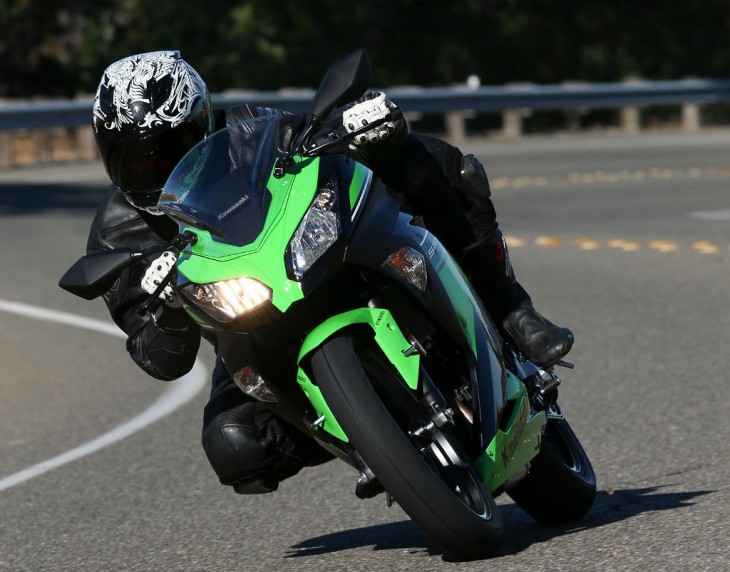
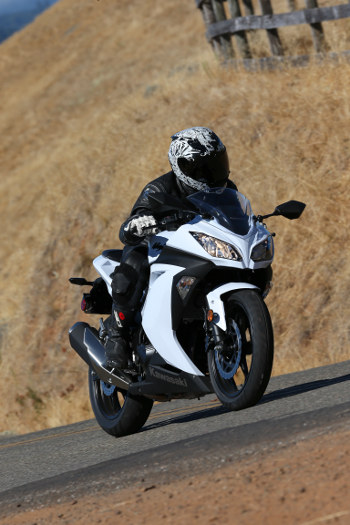
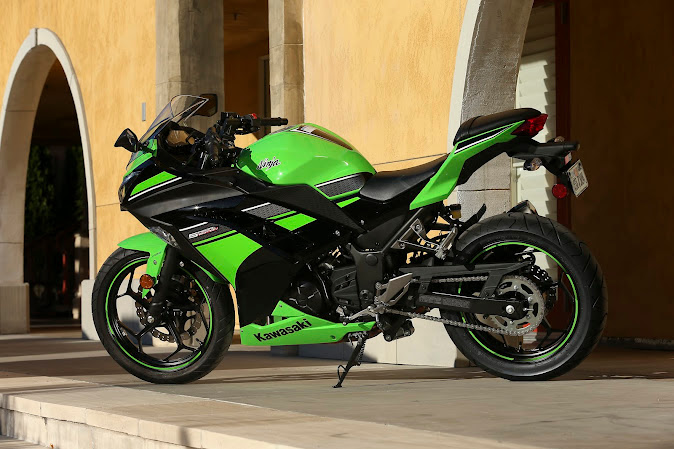
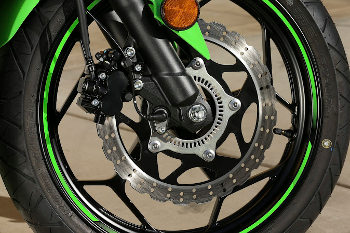
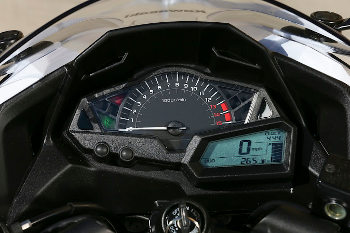
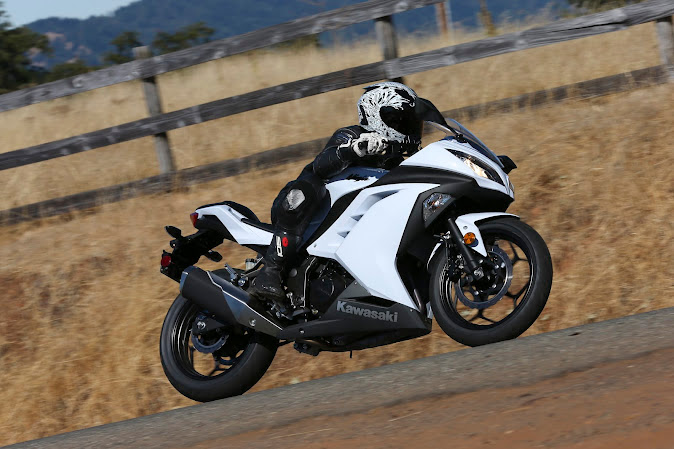
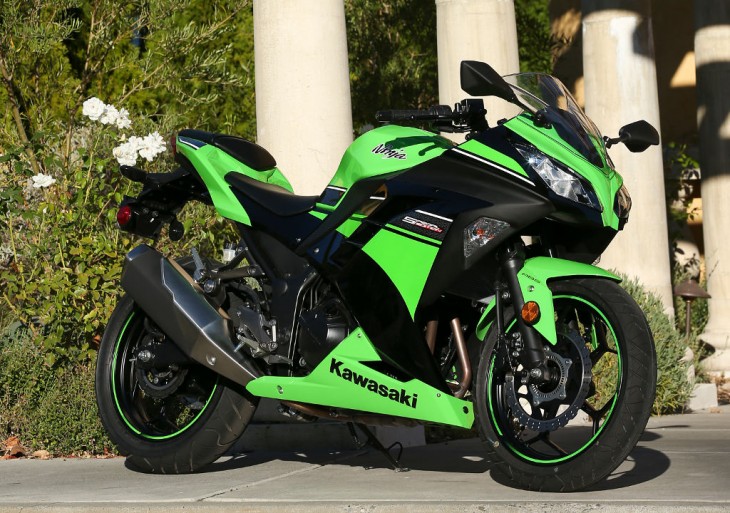






12,200 sportbike sales in 2 quarters, that is low. Thought it’d be 100k plus. The motorcycle market hasn’t recovered as well as the automobile, probably the heavy discounting and 0% interest rate are keeping auto sales buoyant. North America doing better than the black hole of Europe, hope Europe doesn’t sneeze and we catch the flu.
“…one of the best-selling motorcycles in the USA.” Hmmm I totaled your numbers and get 12,200 total sportbikes from all mfg’s. That sales volume doesn’t even seem like it would pay for the tooling. Yegads, HD sold 145,391 units alone in the first half of 2012. Low sportbike sales could be due to the aging of the population, slow economy, pure boredom with it (most kids I know of the age that could enjoy the sport simply stay indoors all day plugged-in to some online game), or attrition. Attrition?.. Daily for several months a kid would peal around traffic in front of my house (long down hill straight) and pass 4 or 5 at a time and you could hear him wail into the distance. My wife said he was dancing on the edge and I said aww leave him alone he’s living large. Well, she called me at work and reported that he finally T-boned a pizza delivery boy at the next intersection and was killed. Oh well, have fun out there while you can, Prodigal Son – get you one of these…
re: “one of the best-selling motorcycles in the USA. Hmmm I totaled your numbers and get 12,200 total sportbikes from all mfg’s. That sales volume doesn’t even seem like it would pay for the tooling.”
to help further put that 12,200 number in perspective, everybody should know by the end of q3 this year the AUTO INDUSTRY has basically sold 12 MILLION vehicles (6 zeros). do the math, that’s 1000 times the number of units sold…!!! trust me, you don’t even want to know what percentage of those cars were MERCEDES and BMW. the rumors of the economy’s demise (at least here in the states) are greatly exaggerated.
That is 12k sport bikes, but still, the US is a pretty small market, when it comes to motorcycles. They are a luxury hobby item for the very few who care.
When a bike is not sold here thats not because its discontinued or not even made, its just not worth the effort to sell a few bikes here so they don’t bother.
If USA started buying 13 million new motorcycles a year, prices per unit might drop, particularly if they were mostly under 250CC.
I don’t know…I’d still much, much rather have a Yamaha WR250X. Fantastic engine that makes about the same power as the Ninja 300…but it’s about 80 lbs lighter!!
Plus nothing give more smiles per mile than a Supermoto….
That is what $6600 msrp will get you….
You didn’t pay MSRP for a WR did you? Maybe you will for the Ninja but dealers need every incentive to move the WR – not that it’s a bad bike, in fact they often get higher praise because of the lighter weight, higher quality, and more powerful motor than the Ninja.
-todd
Nope. I have zero interest in a WR. Wouldn’t take it if it was free. Just pointing out that paying more generally gets you more… You pay more for better build quality. You pay more for less weight. You pay more for more power (or in this case similar power)…
I like to know what a Ninja 300 with a $6600 msrp would be like. ?? Aluminum frame? Ram air? Fully adjustable suspension at both ends? 40+ hp at the tire?
The Yamaha WR250X and R have the most powerful 250cc street legal single-cylinder engines, but they clearly make less horsepower than the twin in the Ninja 300.
That may be true..but not by a huge margin. The WR250X regularly put down 26-28 RWHP on the dyno. The Ninja won’t make much more. Certainly not enough to overcome the 80lb weight difference.
The Ninja will be faster, especially up top (WE has an 85mph top-speed). Most Sopermoto riders are thankful that their bikes only hold 2 gallons of fuel too. They’re not comfortable for any length of time at highway speed and let’s face it, most Americans will see a significant portion of their ride time at those speeds.
DE, my car turns only 2200rpm at 70mph, maybe there is something wrong with you and your
friends car? Your comparing a tiny 296cc engine to your 6 times larger motor, of course it will turn lower rpm at 70 because it produces so much more torque with taller gear ratios in order to pass emissions. Sport bikes have low final drive ratio gearboxes to exploit acceleration just like sequential gearbox race cars, fuel economy is secondary.
re: “At the end of the day, it’s a 296cc parallel Twin, a few pounds heavier than last year, with a claimed 7 hp difference—would I even notice any improvement? Oh my Lord yes.”
ignore the 7hp, the story is in the whopping 8mm increase in stroke. 8mm in and of itself is nothing. mention 8mm in the bedroom and the wife is serving you with divorce papers, but multiply that additional 8 mil’s across 2 cylinders then REPEAT it 7,000 times inside a minute and the cumulative impact on torque is considerably more than the number “7.8” would suggest.
6-7K at (legal) highway speeds is just bad engineering! My Toyota Matrix XRS (high-comp/special-head engine, 6-spd tranny) is turning 4K at 70 and my buddy’s turbo PT Cruiser turned 3K – both with 4 adults aboard. No wonder bikes get such lousy fuel mileage on a trip! If a street bike doesn’t have the guts to pull itself and a rider at 70 with less than 4K revs, the engineers need to go back to the drawing board.
Think you’re on the wrong web site bud.
You mentioned a “turbo PT Cruiser” in your comment. That made me laugh.
Wow.
This has to be a troll.
I am still scratching my head even after re-reading this multiple times.
DE Perhaps it might make more sense to just hop back in your awesome cage and stay clear of these gutless engineering flops.
Corvettes do 70 at about 2k last time I read a review on one. With freakin pushrod engines (pushrods work just fine.)
Its not bad engineering. They designed it the way they did on purpose. It is what it is.
To max out at 3k with a 300cc bike leaves pretty low power levels. Redlining at 50mph?
Want low rpm highway cruising? Go big.
re: “The 2013 uses high-tensile tubing that’s 150 percent stronger, and there’s new gusseting and other changes to make the frame more rigid, rigid enough to rubber-mount the front of the engine.”
see ducati, if the japanese can take advantage of the vastly more diverse properties steel has over ally, you should be able to work MAGIC. too busy…? give reynolds or any one of a 100 of the worlds top push bike makers a call. your parallel frame development awaits.
Ducati did pretty well with steel frames, no?
re: “Ducati did pretty well with steel frames, no?”
in grandprix…?
Yes.The Desmodici was steel framed until the carbon debacle. The GP9 (2009) was the first to have the carbon frame.
I’m used to superbikes (CBR600/929/954/1000/1100XX/R1/R6/ZX14/VFR1200)and I presently have a 2012 R1 & FZ1. I’m sure I would have fun riding this Ninja 300cc. I will probably wait for a demo ride and I’ll see. Enough power to play on the public roads but when you’re used to big bore…
just remember to keep it in each gear longer than you typically would on your big bikes and you’ll move along nicely. Short shift and you’ll think it’s pathetic.
-todd
Reminds me of my Yamaha RD 350. That was a fun bike. With regard to the sales figures at start of story;I am shocked. Less than 12,000 for the US. I knew bikes were greatly over priced due to lack of modern production methods, but at this volume they must be hand made.
Think about it, Honda can build a 4 door FIT with A/C, automatic, power windows, etc for around $16,000 and make money. If they built motorcycles like they build cars you could buy a Goldwing for $12,000 and a 300 for $2,000. Then with sound marketing, we might see some volume
This is why I bought a cbr250r. Can’t wait to see the rebuttal from the other (richer) manufacturers. YES!
Could do without the clip-ons, no way to add risers or change bars to make the thing ridable for us old folks. Glad to see activity in this size range tho!! Maybe Kawasaki will make a standard (or ER3N???) for us???
Pretty sure you can put bar risers on this one same as on the previous generations. I would love to see 300 Eliminator and a standard as well. They could make a killing with a mean little cruiser I’m sure.
That’s a winner , I want one.
How about a naked version that’s a bit taller, a Versys 300 if you will, for guys who can’t fit on this. Also, there’s a lot of us who aren’t into the sportbike look.
I think it could be a great around town and playing in the twisties bike.
Nice work Kawasaki.
I have a complaint against this bike, and others of it’s ilk. Where is my sparkly paint? I don’t like flat green, or shiny white or black if it doesn’t sparkle. Not asking for 2013 Harley sparkle, but my green KH400 was a beautiful SPARKLY green. I want SPARKLIES.
And tassles? ;-))
As a 16 year old I would have died to have a bike like this, it would have stomped the 50cc Aermacchi I had at the time. At 62 however, I have moved past bikes you have to wring the snot out of to get anywhere. I had to chuckle when it said “and enough grunt to pass cars at 80-plus mph in top gear, you’re king of the road, if you’re an aggressive sort. If you’re not, you can cruise along in sixth gear at the speed limit and see a mere 7000 rpm on the tach.” There is not much margin of error if your top speed is 103 and you are trying to pass cars at 80+ … and 7K rpms just to run the speed limit? Holy crap. For people who say its more fun to ride a slow bike fast than a fast bike slow…NO…IT’S NOT! I admit the horsepower some of the most recent big bore bikes are pushing is obscene, but I’d rather have 200 horsepower and only use 100 of them, than to have 36 horsepower and NEED 100.
Another person who has never ridden a 250 ninja? The top speed is probably a bit north of 103. That was just when Gabe ran out of room? Anyway, it should be plenty for US roads. Remember at 7,000 you still have 6,000 RPM to go! The 250 has grown in to a cult favorite for one very good reason. IT IS FUN! The 300 will be even more fun.
kawatwo…I have ridden a Ninja 250. my daughter-in-law bought a black 08 brand new. I rode it several times before she sold it to move up to a bigger bike. Fun in the neighborhood,(heck a Honda Z-50 is fun in the neighborhood too) but no way would I ride that piddling thing more than 50 miles from home and definitly not on the expressway….and you’d have to be crazy to try and pass a car doing 80+ on it unless you are talking about laying on the tank and passing it on a very long open straight stretch of highway.
Good for beginners or short range commuters in this country, high school kids, college kids. Perfect for European cities. There is a reason this class of motorcycle quit selling in the U.S. The U.S. is too big for it.
You know, back in the 70’s and before there were countless small bikes. To a 16 year old a 300cc bike was gettin’ real close to BIG. Interesting how we seemed to get along just fine riding our 50s, 70’s, 80’s 90’s 100’s and so on and so on without real issue to us at least. The US is still the same size, give or take so what we have here is perception and what motorcycles mean to riders and the general public as a whole. Used to be you wouldn’t catch Joe Average American on a Harley dressed for a rumble but today it’s rather quite a popular fashion.
“Interesting how we seemed to get along just fine riding our 50s, 70’s, 80’s 90’s 100’s and so on and so on without real issue to us at least.”
Started riding in 65. There wasn’t much between 50 and 650cc back then. I started on a 50. When I had progressed up to a 305 it seemed huge. But we never road them anywhere. 50 miles from home at most. The 305 seemed big but it was really still small. You are right…. perception. Then I got a 350 and then a 450 then a 750 and on the 750 I could travel state to state with ease in comfort.Then a 1000 and I could travel cross country with ease in comfort… with luggage and a passenger.
I had the opportunity to sit on a restored ’67 305 recently. It was a mini bike lol. I guess if you are not really going anywhere, with anyone,a 300 cc bike will get you there eventually. But I could never go back. Sure it was enough , big even, when I was 16, but I can tell you I could never be happy with a bike that small again, at least for serious riding.
Yes the U.S. is the same size it was in 1965. Some of us are just riding around more of it these days.If a 300 was all that we wanted/needed, it’s all the mfgs would build. Truth is even 46 years ago we weren’t happy with 300s and wanted more. Heck just in this thread people are wishing that this was a 400/450/500.
I have a 104hp sport bike and have never once needed all of it. The margin for error on this will be much wider than it is in any average car. I know what you mean about the 7k/rpm thing but a modern 600 turns at least 6k at the same speeds. The old 250 was at 8.5-9k at the same speeds. I’d love to wring one of these out, maybe even own one.
I’ve been driving for 31 years and never had a car above 90mph. To suggest that you need a vehicle capable of speeds north a 103mph to be safe is hogwash. 103mph is enough to safely take you down any road I have traveled in the US. That extra 10-20 mph on the top end is what separates this 300 from many of it’s 250cc predecessors like the CRB250, TU250, Rebel and Vision 250’s. While it may not be my 1st choice for extended freeway riding, it is freeway capable.
They are asking too much money for a sub-300cc bike.
$5,499. My brother bought a brand new, leftover Kawasaki ER-6N for that exact same price two years ago – now that’s deal!
In any case, the little Ninja seems like a good value for $5500 with just enough ummph to make viable on US freeways and interstates. And it looks fantastic.
I promised myself no more bikes until the EX hits 100k or I sell the FJR, but….. does it have a centerstand? Does HB make hard bags for it yet. Oh my.
I wish it were more of an inner city naked standard or a commuter or even ADV tourer.
At least they stroked it, so that should make it more torquey, less whiney.
Yeah, right? I asked the product planners if anything like that was in the works and they just kind of stared at me blankly…or they might of said something but I was drinking a margarita and I think I got distracted…
This bike reminds me of the old Yamaha FZR-400s of yesteryear. Oh, how i wish i had 5k to drop on this.
Gary Jaehne would have loved that Bike! He was MR 250 in Norcal!
I know! I miss Gary too.